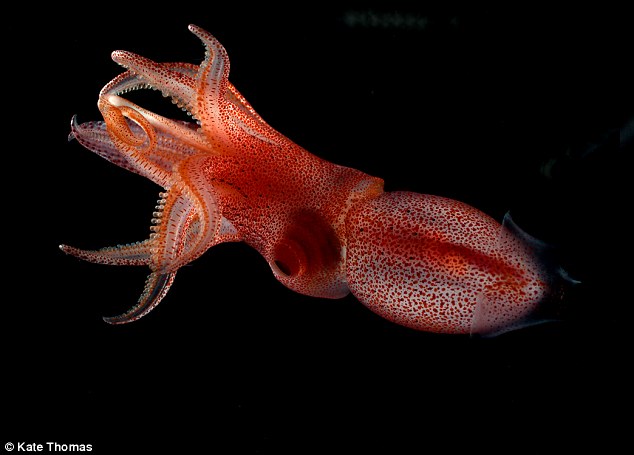From eyes the size of basketballs to appendages that glow, deep-sea dwellers have developed a range of weird and wonderful features to help them survive their cold, dark habitat according to Daily mail.
But with one tiny eye and one giant, bulging, yellow eye, this bizarre squid has one of the strangest adaptations of all.
Researchers have studied the cockeyed sea creature, and believe the lopsided eyes may be an adaptation to allow the squid to see in both light and dark depths.
A team of researchers, watched Histioteuthis squids – otherwise known as strawberry squids – swimming in more than 150 videos.
Their observations suggest that the animal uses its large eye to gaze upwards, searching for shadow of other sea creatures, while the small eye is adapted for looking downwards, scanning darker waters in a layer of the ocean known as the twilight zone.
Professor Sonke Johnsen, senior author of the study, said: ‘The deep sea is an amazing natural laboratory for eye design, because the kinds of eyes you need to see bioluminescence are different from the kinds of eyes you need to see the basic ambient light.
‘In the case of the Histioteuthis, this cockeyed squid, they chose one eye for each.’
Strawberry squids live in a region of the ocean known as the mesopelagic or ‘twilight’ zone, 200 to 1000 metres below the surface.
The little light that reaches these depths is very dim, and travels straight down from above.
Bioluminescense from other sea creatures, which could signal danger, is often brighter than the ambient sunlight
In the videos, the researchers found that the slow-moving squid preferred to drift through the sea with its head down, and tail up, but nearly vertical.
Using computer simulations, the researchers showed that because sunlight only comes from above, it would be nearly impossible for an eye angled downwards to spot silhouettes against the light.
But while the upwards looking eye is large to optimise its ability to spot silhouettes, the second eye is only really looking for bioluminescence so does not need to be as big.
Kate Thomas, lead author of the study, said: ‘The eye looking down really only can look for bioluminescence.
‘There is no way it is able to pick out shapes against the ambient light.
‘And once it is looking for bioluminescence, it doesn’t really need to be particularly big, so it can actually shrivel up a little bit over generations.
‘But the eye looking up actually does benefit from getting a bit bigger.’
While you might think that two big eyes would be a better strategy for surviving in the dark ocean, the researchers explain that this isn’t the case.
Ms Thomas added: ‘Eyes are really expensive to make and maintain.
‘You want eyes just big enough to do what you need to do, but you don’t want to have any bigger eyes because then you are just wasting resources.
N.H.Kh

